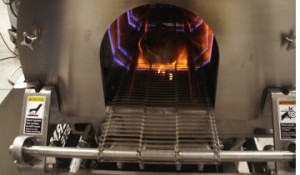
Flame pasteurizing sizzles
Food in Canada
Facilities Maintenance Food SafetyA breakout solution for pathogen control increases shelf life and productivity of RTE meats
To achieve the necessary food safety and cooking efficiencies, many meat and poultry items such as ham, turkey and chicken are today cooked in a pouch or bag, using water or steam, and then chilled. However, when processors need to add colour, texture or flavourful seasonings in order to satisfy consumers’ taste preferences, additional post-processing is required. The question is, what is the best way to attain those desired effects and also maintain extended shelf life?
The answer for many processors today is a breakout technology that can roast, flavour, sear and colour meat and poultry while also providing the needed surface pasteurization to significantly extend shelf life – the “tunnel of fire” pasteurizing and flash roasting system.
Using the flame tunnel processors simply take the cooked and chilled whole poultry or meat products from the chiller and place them on a belt that moves the products through an enclosed flame. The flame will then colour, sear and surface-pasteurize the products so that they are ready for immediate packaging. Because of the speed of the process – normally 30 to 60 seconds – complete surface pasteurizing and searing is achieved, yield loss is minimal and a long shelf life is ensured.

Using the flame tunnel processors simply place the cooked and chilled meat on a belt that moves it through an enclosed flame. The unit will colour, sear and surface-pasteurize the product so that it is ready for immediate packaging.
Flame tunnels such as Unitherm Food Systems’ Tunnel of Fire also include a dispensing unit that sprays browning and flavouring agents such as liquid smoke or other seasonings onto products as they enter the tunnel. This allows the colour, texture and taste of products such as barbecue, rotisserie-style chicken and honey-roasted ham to be easily and consistently controlled.
Using this flash roasting and pasteurizing process, finished products maintain their cool core temperatures, and can be immediately packaged for distribution. This eliminates food safety problems that can occur when products are cooled in the open air prior to packaging, which exposes them to cross contamination that can limit shelf life to a few days rather than weeks.
Shelf life of 40+ days
Roasted chicken provides a good example of how the right flame roasting and pasteurizing process and equipment can meet customers’ taste preferences while also extending shelf life.
Comercializadora Andina SA (Comansa) of Santiago, Chile produces a line of foods sold to supermarkets, including chicken, beef and other meats, plus a ready meal line that is mainly provided for the Chilean School Feeding Program.
One of the company’s primary products is roasted chicken, which is sold to supermarkets throughout the country at the rate of about 80,000 units per month. Comansa Operations manager Eduardo Carvajal says that providing rotisserie-style chicken and an assortment of seasonings has enhanced sales while offering other benefits.
“We cook the chicken in bags in a steam tank for about three hours, then chill it in the same unit,” he explains. “Afterwards we put the chicken through the Unitherm Tunnel of Fire to keep surface pasteurizing, and get the colour and develop the seasonings. This is all done in just 30 to 35 seconds.”
Carvajal says that using the flame tunnel provides important benefits besides the assurance that each chicken is exposed to the air for only seconds before it is surface pasteurized and put in retain bags immediately afterwards, ensuring that it will remain safe. “The colouring process of the flame tunnel is very important because our customers prefer that finish rather than a plain white colour,” he says. “Also, the same equipment enables us to provide a variety of seasonings, including spicy, barbecue, butter and sweet flavours.”
One of the most important benefits of the flame pasteurizing process is the extended product shelf life. While many roasted chickens have a typical shelf life of about three days, Carvajal’s is considerably longer. “After we ship the chicken, we are certain of a shelf life of 42 days,” Carvajal says, “and that is an important reflection of our high standards.”
Speeding throughput
Since 1970 Luka Meats (Luka Vleeswarenfabriek NV) of Vilvoorde, Belgium, has offered a variety of cooked ham, including smoked, roasted and extra lean ham, as well as Strasbourg meat loaves. Until recently, ham and Strasbourg loaves were pasteurized, browned and seared by hand, using a hand-held torch. But handling 1,200 hams and 300 to 400 loaves per week was just too time consuming.
“We used to spend an average of two hours a day finishing these products by hand,” says Thomas Leemans, Luka Meats founder and owner.
Recently, Luka Meats automated its pasteurizing process with a Unitherm Tunnel of Fire flash roasting system. “This new equipment makes quite a difference in productivity,” says Leemans. “We now save approximately 60 per cent of the time it used to require to brand our products by hand, as well as considerable labour.”
For more information visit www.unithermfoodsystems.com
Print this page